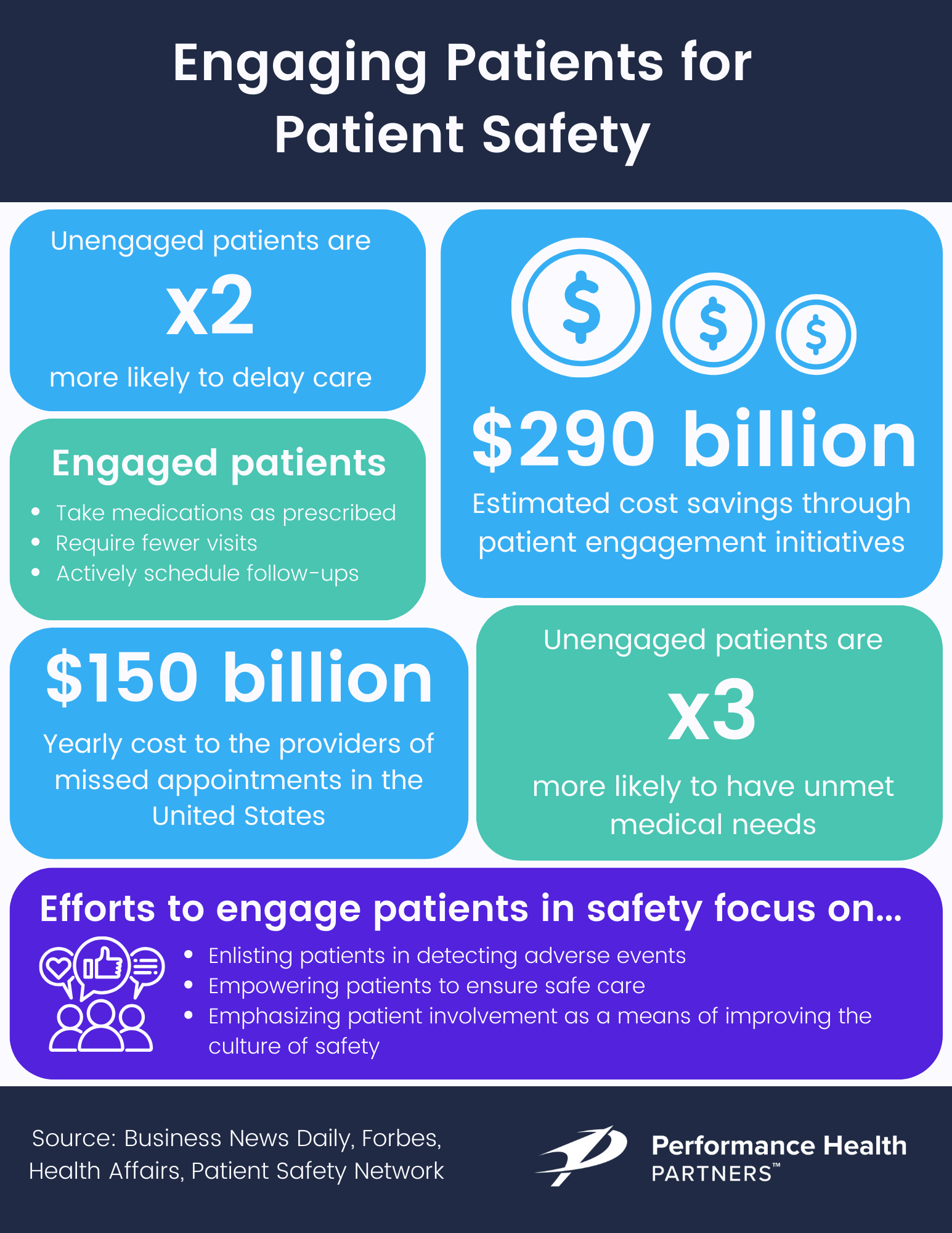3 min read
Patient Engagement: A Guide to Driving Better Outcomes
Performance Health Partners
August 28, 2023

Patient engagement begins when patients are treated as partners, rather than simply recipients of care. Through this engagement, individuals not only reclaim authority over their health but also foster a deeper bond with their care providers. Moreover, such engagement paves the way for transformative progress in healthcare. Continue reading to learn more about the importance of patient engagement and how to seamlessly weave it into your organization's fabric.
Why is it Important to Involve Patients in their Care?
It is extremely important to involve patients in their care, as patient engagement has countless benefits. Among them include:
Enhanced Outcomes & Safety
Engaged patients tend to have improved health outcomes. When patients actively participate in their care, they are more likely to adhere to treatment plans. Armed with an understanding of their care regimen, patients are more likely to identify mistakes or discrepancies in their plans. This vigilance can help reduce medical errors and improve patient safety.
Boosted Patient Satisfaction
When patients play a central role in decisions concerning their care, they feel more respected. This results in heightened satisfaction levels.
The added bonus? Engaged patients utilize healthcare resources wisely. Their informed perspective on their condition enables them to discern when to seek medical attention. As a result, they're less prone to needless hospitalizations or emergency department visits.
A compelling statistic to note: Enhanced patient engagement can reduce readmission rates by up to 14%, mitigating healthcare costs due to fewer complications.
Improved Treatment Adherence
According to the American Medical Association, patients do not take their prescribed medication about half of the time.
Contrast this with engaged patients who demonstrate a higher likelihood to stick to treatment plans and medications. This diligent adherence accelerates recovery and bolsters the management of health conditions. The symbiotic relationship between patients and providers, cemented by trust, enhances overall satisfaction levels.
Promoting Transparent Communication
Open dialogue between patients and providers is a cornerstone of effective healthcare. Encouraging patients to voice concerns and seek clarity not only builds patient trust but also helps providers fine-tune care plans. Furthermore, well-informed patients tend to seek timely medical intervention at the onset of symptoms. This proactive approach often leads to early detection and subsequently, more effective treatment.

The Role of Patient Engagement in Provider Selection
Choosing a healthcare provider is a significant decision for patients, influenced by several factors, with patient engagement topping the list.
Reviews and recommendations play a pivotal role.
Consider this: 90% of patients seeking healthcare services turn to online reviews, as per Software Advice. They value patient-centric care and often lean towards providers known for collaborative and engaging care approaches.
The underlying desire? A healthcare institution where trust isn’t just promised, but delivered.
Elevate the Voice of Patients
To elevate the voice of patients, it is important to provide many outlets for patients to contribute and speak up.
- Create a Patient Advisory Council: Organizations can create councils made up of patients, families, and caregivers. This provides a community to communicate and provide recommendations.
- Online Patient Communities: These platforms offer a space for patients to share experiences and offer mutual support. Ninety two percent of patients report that an online health community plays an important role in their health decisions.
- Partner with Established Patient Advocate Groups: Healthcare organizations can partner with already established groups. Such collaborations can amplify patient voices, ensure their needs are prioritized, and bring valuable insights into the healthcare process.
- Involve Patients in Quality Improvement Initiatives: Asking patients to contribute to changes going on in the hospital provides them with a way to directly create changes.
- Gather Direct Feedback: This could involve conducting regular patient surveys to gather feedback on patient experiences. Other than a survey, healthcare groups can host focus groups or interviews with patients to get a deeper understanding of their needs and experiences.
- Care Plan Development: During patient care, it is important to develop care plans that incorporate the patient's goals and values. It is also essential that patients actively participate in the creation of their plans. A study found that only 36% of participants felt that they were involved in the planning of their discharge from hospitals.
- Host Workshops or Seminars: Patients can learn about healthcare topics to help them have more knowledge and be stronger advocates. Providing various patient engagement activities will not only make patients more involved in their care but make them feel more comfortable and trusting of providers.
Patient Engagement Strategies
- Education and Information Sharing: Provide patients with clear information on their condition and treatment options. Offer written material and online resources to help patients better understand their health.
- Patient Portals: Provide patients with access to secure online portals where they can view their records, make appointments, and send messages to providers. Patient engagement technology can help make patient care more accessible. 58% of patients under 55 and 63% of patients over 55 claim that quick responses to follow-up questions play an integral role in their patient satisfaction.
- Incident Reporting Software: Adopt an incident management system to indirectly help patient engagement by promoting a culture of safety, transparency, and collaboration. This will lead to positive outcomes, creating a better patient experience.
- Health Coaching and Self-Management: Offer health coaching to help patients set and achieve health goals. Provide patient engagement tools to track progress and self-monitor health.
- Patient Rounding: Incorporate patient rounding to demonstrate a commitment to patient-centered care. This process creates an environment that encourages open communication and patient involvement. This proactive approach of having providers regularly visit and interact with their patients will make patients feel more involved in their care.
- Patient Advisory Groups: Establish patient advisory groups to seek input and allow patients to share stories.
- Patient Feedback and Surveys: Gather patient feedback to assess their experiences and identify areas of improvement. By using patient engagement software, providers can easily keep track of a variety of feedback and make a central location for patients to provide their comments. Implementing a survey solution allows patients and visitors to provide their feedback through an easy-to-use QR code-activated survey.
Ready to learn more?
Want to learn more about how Performance Health Partners’ software can help your organization improve patient engagement? Click here to get started.


